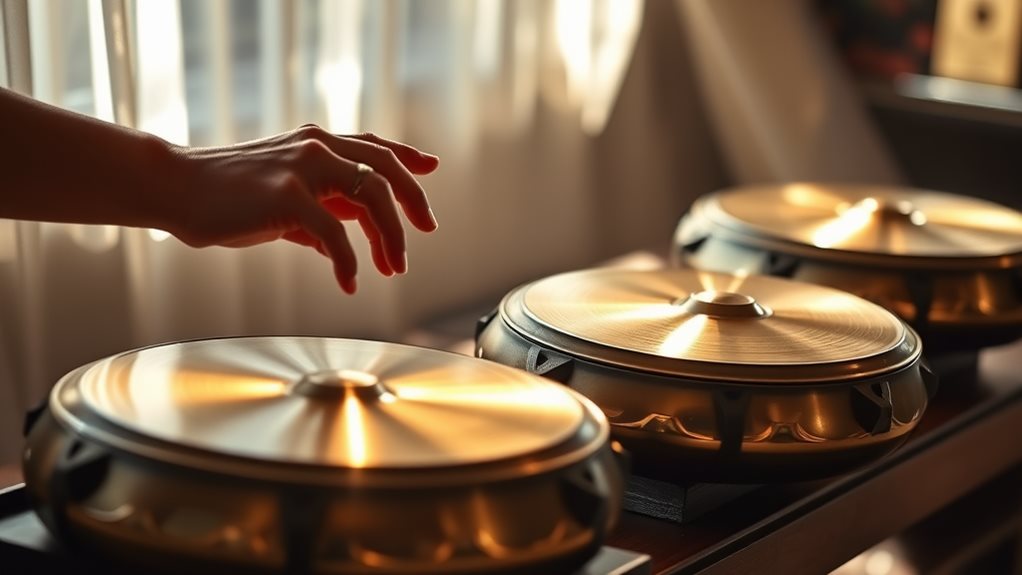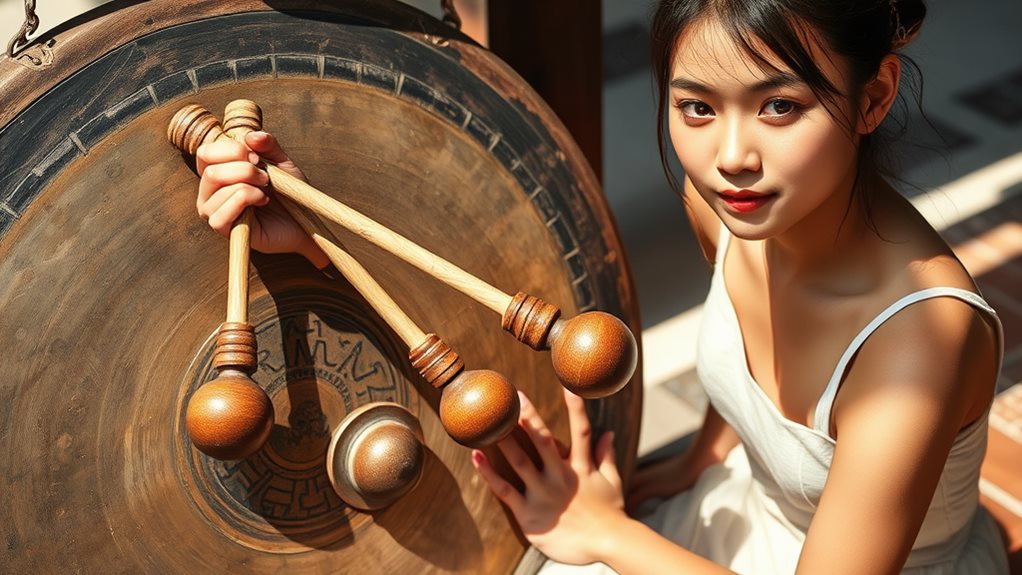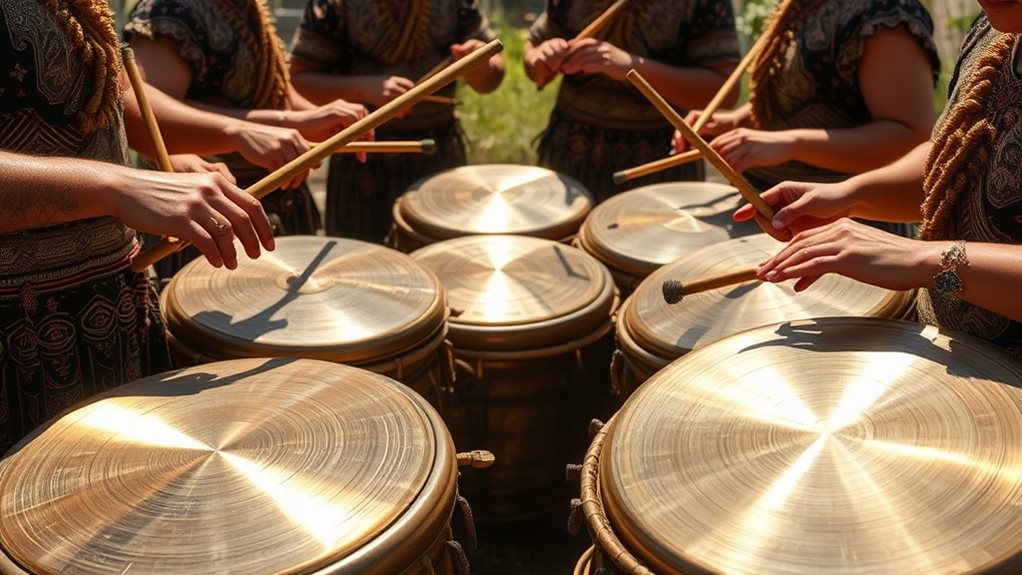Position the gangsa on your lap with the playing surface facing up, maintaining a comfortable, straight-backed posture. Use wooden mallets with padded heads to strike near the center for fuller tones. Keep fingers relaxed for smooth movement and control dynamics by adjusting your strike force. Practice striking at perpendicular angles to achieve clear notes. Focus on syncopation and study polyrhythm patterns for complex rhythms. Participate in community events to foster pride and collaborative performances. Exploring further develops mastery in Cordilleran gong music.
Understand the Gangsa

To truly grasp the essence of the Gangsa, within the context of the Cordillera region, you must familiarize yourself with its construction from bronze or brass, and how it produces a resonant tone when struck.
This gong instrument is hand-held with a smooth surface and a narrow rim, allowing for a variety of playing techniques and sound variations. You can play the Gangsa using a mallet or even your palms, and mastering these techniques requires precision and practice to produce the best sound quality.
Typically, the Gangsa is part of an ensemble, where coordination and synchronization are key to achieving harmonious music.
During cultural celebrations and rituals, the Gangsa not only provides musical accompaniment but also serves as a medium for storytelling and heritage preservation, making it a vital part of the Cordillera region's cultural tapestry.
Hold the Instrument Properly
Placing the Gangsa on your lap with the playing surface facing upwards maximizes resonance. Sit in a comfortable position with your back straight to facilitate better control and endurance during play.
Keep your fingers relaxed, positioned on the edge of the gong, to allow for fluid movement when striking. Use your palm to strike the surface of the Gangsa, ensuring that the impact point is near the center for a fuller sound.
Adjust your grip to avoid excessive pressure, allowing the instrument to vibrate freely for optimal sound quality. Holding the instrument this way aligns it with the traditional methods, which the Gangsa is usually played, ensuring you capture the true essence and depth of its vibrations.
Remember, while the Gangsa may complement the nasal flute in some traditional settings, understanding how to hold and play each instrument separately is crucial.
Cancel anytime if you feel uncomfortable or need to make any posture adjustments.
Use Mallets Effectively

A key element in mastering the gangsa involves using mallets effectively. Choose a wooden mallet with a padded head; this choice enhances mallet materials by producing a warm, resonant tone while protecting the gangsa's surface.
When adjusting striking techniques, aim for a perpendicular angle to the gong to elicit a clear, vibrant note. Alter the force of your strikes to control sound dynamics; softer taps create mellow sounds, whereas harder strikes yield louder, more pronounced tones.
Experiment with various striking locations on the gong; hitting the center for a fuller sound or the edge for sharper tones can enrich your playing.
Hold the mallet with a relaxed grip, facilitating smooth wrist movement essential for executing complex rhythms and dynamics.
Strike Evenly for Tone
Ensuring you hit the center of the gong with even force, which is essential for producing a clear and resonant tone, you should use a wooden mallet and adjust your grip to maintain control and precision throughout your performance.
This involves holding the mallet loosely but firmly, positioning your fingers around the handle for maximum support.
Focus on your striking techniques, fine-tuning your wrist movement to strike straight down from various heights to vary the impact and tonal quality.
Tonal exploration requires shifting the angle of the mallet slightly, experimenting with edge strikes for bolder sounds or softer center taps for delicate notes.
Rhythmic precision calls for disciplined timing, listening to the gong's resonance and aligning your strikes to fit within the broader musical context.
Regular practice sharpens your ability to execute these techniques consistently, enhancing sound quality and allowing you to deliver nuanced performances with ease.
Practice Ensemble Techniques

Maintaining precise timing and rhythm when playing with others is key to achieving harmony in ensemble performances. To develop these skills, start by focusing on timing coordination. Listen attentively to the other musicians, and aim to match their beats precisely. Practice clapping along with a recording of the piece or using a metronome to refine your sense of timing.
Next, consider ensemble dynamics. Experiment with varying the intensity of your striking force and adjust your mallet angle to blend with the overall volume and timbre of the group. This collective practice will ensure a balanced and cohesive auditory experience.
Lastly, adopt effective rehearsal strategies. Regularly attending rehearsals, reviewing your parts, and addressing any discrepancies or irregularities promptly can significantly improve the synchronization and musicality of the ensemble.
Following these guidelines will help you perform in unison, enhancing the cultural and musical significance of the gangsa in your ensemble.
Learn Traditional Rhythms
Traditional rhythms in Gangsa music are based on intricate patterns that emphasize syncopation and polyrhythms, reflecting the cultural heritage of the Cordillera region.
To learn these rhythms, you start by mastering syncopation techniques, focusing on off-beat placements within a measure to add complexity. Simultaneously, studying polyrhythm patterns, where multiple conflicting rhythms are played simultaneously, enhances your rhythmic vocabulary.
Learning these rhythms relies heavily on the oral tradition, so pay close attention to experienced musicians, practicing by listening and imitation.
Rhythmic structures cycle and repeat, allowing for motif development and unity among ensemble players. Understanding the cultural context of these rhythms, their roles in rituals and celebrations, deepens your appreciation and performance quality.
Incorporate Regional Styles

Exploring various regional styles of Gangsa playing reveals a plethora of cultural traditions and musical nuances specific to different Cordillera tribes.
To effectively incorporate regional styles, you should:
- Study historical and cultural significance: Delve into the history and context of how the Gangsa is used in specific regions. This understanding will help you appreciate the deeper meaning behind each style.
- Master local techniques: Practice the unique striking forces and mallet angles used by performers in your area. These local techniques produce sounds that are distinct and culturally important.
- Participate in collaborative performances: Work with local musicians to blend different styles during live performances. Collaboration fosters a richer musical experience and honors diverse cultural expressions.
Preserve Cordilleran Heritage
By delving into the rich and varied traditions of the Gangsa in Cordilleran communities, you not only cherish the integral role it plays in celebrations and rituals but also ensure its cultural heritage is passed down to future generations. Engaging in community classes and workshops allows you to learn the musical heritage of the Gangsa, while also fostering community engagement. Schools collaborate with local musicians to integrate Gangsa lessons into their curriculum, teaching students about the cultural significance of their heritage. Online resources provide further study materials, enhancing your skills. Here is a breakdown of effective strategies for preservation:
| Strategy | Method | Impact |
|---|---|---|
| Community Classes | Organize regular playing sessions | Increases familiarity and skill among all ages |
| School Integration | Incorporate Gangsa in music classes | Educates youth about cultural heritage |
| Online Resources | Access digital tutorials and videos | Facilitates self-paced learning and accessibility |
| Performances | Participate in community events | Strengthens community pride and identity |
| Collaborative Efforts | Work with cultural groups and NGOs | Combines resources for broader cultural impact |
Questions and Answers
How Is Gong Cordillera Played?
Gong traditions in Cordillera involve cultural significance through ensemble performances, using varied striking techniques with mallets or hands for dynamics and rhythm, requiring practice and coordination.
How Do You Play the Gangsa?
To play the gangsa, hold it on your lap, use your bare palms, and master technique variations. Understand its cultural significance and adapt to varied performance settings for a rich musical experience.
What Is the Gangsa Instrument of Cordillera?
The Gangsa, with its rich history and cultural significance in Cordillera, plays essential roles in community events. Variations across sizes produce diverse pitches, enhancing ensemble music quality.
How Is a Gong Played?
Playing a gong involves striking it with techniques using mallets, sometimes palms, generating diverse tones, emphasizing cultural significance, and integrating into various musical styles.